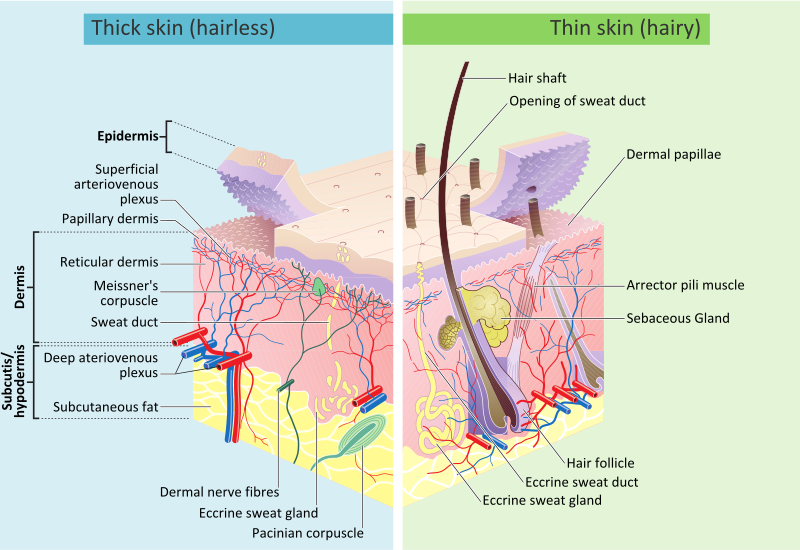Structure Of Human Skin
The structure of the human skin can be broken down in many ways -- many layers of complexity. In light of the subject matter, we will start simple and then work our way (through the series) into more detail. Below is the classical structure of human skin taken from the 'Wikipedia' page on "human skin":
Source: By Madhero88 and M.Komorniczak
At first sight, the image might be daunting. No worries, unless you are a dermatologist or a medical school student, you will not be quizzed over the material. The point of showing the image above is to illustrate that there are different layers of that make up skin. Furthermore, each layer has a specific role to play in the overall function of skin (as we shall see).
In the description of the "structure" of skin, there are numerous facts disjointedly put together. According the "Wikipedia" the structure of skin (section) should contain the following opening two paragraphs (overview) shown below:
Skin has mesodermal cells, pigmentation, such as melanin provided by melanocytes, which absorb some of the potentially dangerous ultraviolet radiation (UV) in sunlight. It also contains DNA repair enzymes that help reverse UV damage, such that people lacking the genes for these enzymes suffer high rates of skin cancer. One form predominantly produced by UV light, malignant melanoma, is particularly invasive, causing it to spread quickly, and can often be deadly. Human skin pigmentation varies among populations in a striking manner. This has led to the classification of people(s) on the basis of skin color.[7]The skin is the largest organ in the human body. For the average adult human, the skin has a surface area of between 1.5-2.0 square metres (16.1-21.5 sq ft.). The thickness of the skin varies considerably over all parts of the body, and between men and women and the young and the old. An example is the skin on the forearm which is on average 1.3 mm in the male and 1.26 mm in the female.[8] The average square inch (6.5 cm²) of skin holds 650 sweat glands, 20 blood vessels, 60,000 melanocytes, and more than 1,000 nerve endings.[9][better source needed] The average human skin cell is about 30 micrometers in diameter, but there are variants. A skin cell usually ranges from 25-40 micrometers (squared), depending on a variety of factors.Skin is composed of three primary layers: the epidermis, the dermis and the hypodermis.[8]
The description of the structure above is fragmented to illustrate the far reaching parts of the structure of skin. Although, there are good pieces of information and should not be dismissed in any manner. In all fairness to the authors of the content on the page, the breakdown and descriptions go into greater detail as the reader progresses down the page (with a lot of information).
From the standpoint of the purpose of the series on science and aging skin, the following questions must be answered to tie the current blog post to the 'Anti-Aging Skin Series':
1) What is pertinent about structure to understand anti-aging of the skin?
2) What is the function of each pertinent element of the structure of skin?
While the two questions above are important to address in the context of the blog post series, the function of the skin is the basis for the structure of the skin. Structure (of the skin) defines function! That is a very important point to keep in mind. Especially, when concerning oneself with the application of skin care products. Not all skin care products are good for the skin -- in regards to the function of the skin. Remember what the functions (purposes) skin serves for the human body:
1) keeping water in and chemicals out -- natural barrier toward infection
2) serves as padding for bones and other organs
3) serves as a temperature control system for the body
Conclusion...
Obviously, as a scientist, I like to learn as much as possible. Although, in the interest of brevity, I will stick to answering the two questions above. As we move forward in future posts, I will refer back to this page and add to the stated information in greater detail as the information pertains to answering the global question: Can Science Really Reverse Aging Skin?
Starting off easy -- i.e., from a global perspective will give you a chance to think critically about the skin care products that are on the market that advertise any benefits in terms of 'anti-aging' properties. If by chance I skip over any, please feel free to leave questions and comments in the comments section and I will try to incorporate them into the series.
Remember, I am a chemist. Skin care formulation is not my profession. I am an instrument manager at a University. Analysis of research is my area currently -- seeing that I maintain the usual army of instruments that you would find in any chemistry laboratory across the world. One of the main reasons that I am writing this series is to demonstrate that the majority (98%) of my sources will be open source or information that is online. I hope that in writing these posts, I pass on the confidence onto you to search and do research 'online' for yourself into the hazards associated with the chemicals found in consumer products.
Until next time, have a great weekend!!!!

No comments:
Post a Comment